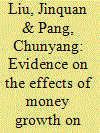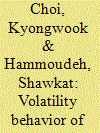|
|
|
Sort Order |
|
|
|
Items / Page
|
|
|
|
|
|
|
| Srl | Item |
| 1 |
ID:
155300


|
|
|
|
|
| Summary/Abstract |
This paper develops a panel smooth transition vector autoregressive model to investigate the economic growth–defense causality. This model simultaneously resolves the estimation problems of endogeneity, heterogeneity, and nonlinearity. Empirical results support that the causality is bidirectional, nonlinear, time- and country-varying. Economic growth has a negative impact on military spending and vice versa. The larger the HDI, the smaller the negative causality. Evidently, the increase in the level of country development can reduce the negative impact of military outlays on economic growth. Reducing the ratio of military spending to GDP is beneficial for countries with low HDI scores; however, moderately increasing the share of military expenditure is favorable for countries with extremely high HDI scores. Policy authority needs to set optimal education, health, and economic development shares of GDP for purchasing a maximum economic growth rate.
|
|
|
|
|
|
|
|
|
|
|
|
|
|
|
|
| 2 |
ID:
110249


|
|
|
|
|
| Publication |
2012.
|
| Summary/Abstract |
This paper introduces a regime-switching forward-looking Taylor rule to describe the monetary policy behavior and considers its estimation using a two-step MLE procedure due to Kim and Nelson (2006), Kim (2009) and Zheng and Wang (2010). By doing an empirical analysis on quarterly data for China over the period 1992-2010, our results show that the actual reactions of China's monetary policy can be well characterized by a two-regime forward-looking Taylor rule. Furthermore, it is also suggested that the interest rate policy in response to inflation and output gap is asymmetric, behaving a significant characteristic of regime-switching nonlinearity. Specifically, in the first regime the People's Bank of China targets inflation, but not focuses on the output gap; while in the second regime the central bank targets the output gap and the policy rule is not a stable framework.
|
|
|
|
|
|
|
|
|
|
|
|
|
|
|
|
| 3 |
ID:
108390


|
|
|
|
|
| Publication |
2011.
|
| Summary/Abstract |
Since the latter half of 2010, a new round of inflation has gradually been manifesting in China. The debate regarding whether excess money supply is responsible for this inflation has attracted scholars to investigate the effects of money growth on inflation. In this paper, we use correlation analysis to confirm the comovement between growth of monetary aggregates and inflation. We explore the asymmetric effects of monetary policy on inflation using the Markov regime-switching model. The empirical results show that monetary policy can be more effective in curbing inflation in a high inflation state than in boosting the price level in a low inflation state. However, simply tightening the money supply might not be sufficient to suppress the price level. To this end, the Chinese Government should adopt other policies, such as supply stabilization policies, to help suppress the price level. Our study can help policy-makers to determine the actual economic state and provides some policy implications for the current inflation.
|
|
|
|
|
|
|
|
|
|
|
|
|
|
|
|
| 4 |
ID:
160002


|
|
|
|
|
| Summary/Abstract |
The present study investigates the influence of international oil prices on China's stock market returns across 29 different industries. The paper attempts to account for any structural breaks and nonlinearity in this relationship. The results reveal that the effect of changes in the international price of oil on stock returns differs substantially across industries. The stock returns of the coal, chemical, mining and oil industries are found to be positively affected by crude oil price movements. Conversely, electronics, food manufacturing, general equipment, pharmaceuticals, retail, rubber and vehicle industries are found to be negatively affected by movements in the price of crude oil. The results of the estimations also suggest that the majority of Chinese industries have been significantly affected by oil prices since 2004. The influence of international oil prices on Chinese stocks also has a stronger effect in the presence of high volatility but the effect varies across industries.
|
|
|
|
|
|
|
|
|
|
|
|
|
|
|
|
| 5 |
ID:
097339


|
|
|
|
|
| Publication |
2010.
|
| Summary/Abstract |
This study supplements previous regime-switching studies on WTI crude oil and finds two possible volatility regimes for the strategic commodity prices of Brent oil, WTI oil, copper, gold and silver, and the S&P 500 index, but with varying high-to-low volatility ratios. The dynamic conditional correlations (DCCs) indicate increasing correlations among all the commodities since the 2003 Iraq war but decreasing correlations with the S&P 500 index. The commodities also show different volatility persistence responses to financial and geopolitical crises, while the S&P 500 index responds to both financial and geopolitical crises. Implications are discussed.
|
|
|
|
|
|
|
|
|
|
|
|
|
|
|
|
|
|
|
|
|